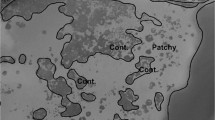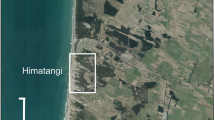Abstract
Great Lakes wetlands have lost much of their historical extent, structure and function. Their transformation was influenced by a number of factors acting over a period of decades including modifications in the basin's hydrology (watershed drainage, dikes, lake levels), biology (exotic species), geology (sediment transport and composition), and chemistry (water quality). The relative importance of each of these catalysts likely varied from region to region and depended on pre-settlement conditions and natural variability in the marshes, both generally unknown. We applied Geographic Information Systems (GIS) technology to a 120-year record (1872–1991) of images of a 2000-ha marsh system along the southwestern shore of Lake Erie, Ohio, USA. Long-term variability in aggregate characteristics of wetland vegetation was linked with environmental changes and human impact in three regions representing (1) a naturally existing open marsh with the lowest relative topograhical elevation, (2) an open marsh with a protected exposure to the lake and higher elevation, and (3) a diked marsh with manipulated water levels. The deep, open marsh lost half of its emergents, and a third of its patchiness and edge habitat in the early 1900s, when severe watershed degradations accompanied relatively low Lake Erie water levels. Nearly all remaining emergents were eliminated between 1940 and 1991 in this open marsh, following progressively higher lake levels. In the protected open marsh, the extent of emergents fluctuated with lake levels until 1977, and declined severely since then during sustained high lake levels. Habitat parameters varied little until recent decades, but declined markedly thereafter. The diked marsh maintained pre-1900 conditions for emergent plants, patchiness, and habitat edge; variability was linked to breached dikes and the presence/absence of marsh management. No landward re-establishment of the entire marsh complex since 1873 was evident on the 10 images studied. We propose the interaction of three forcing functions as the principal mechanism controlling the historical and current distribution of aquatic plants in southwestern Lake Erie marshes. These factors, collectively referred to as the Landward Advance Paradigm (LAP), include (1) the restricted ability of the marshes to advance landward, (2) sustained above-average lake levels, and (3) the presence of carp ( Cyprinus carpio) in wetlands with silt and clay sediments. Management focused on enhancing the role of Lake Erie wetlands should consider these landscape-level alterations and attempt to maximize wetland functions within the context of the LAP.
Similar content being viewed by others
References
Bookhout, T.A., Bednarik, KE. and Kroll, R.W. 1989. The Great Lakes' marshes. In: Habitat management for migrating and wintering waterfowl in North America. Texas Tech. Univ. Press, Lubbock, Texas. pp. 131-156.
Bourne, S. 1820. Survey of Winous Point and Ottawa Shooting Clubs. Wareham, MA.
Burton, T.W. 1985. The effects of water-level fluctuations on Great Lakes marshes. In: Price, H.H. and D'Itri, F.M. (eds), Coastal Wetlands, Lewis Publ. Inc., Chelsea, MI.
Forman, R.T.T. 1995. Land Mosaics: The Ecology of Landscapes and Regions. Cambridge University Press, Cambridge, UK. 632 pp.
Gottgens, J.F. and Liptak, M.A. 1998. Long-term assimilation of agricultural runoff in a Lake Erie marsh. Verh. Int. Ver. Limnol. 26: 1337-1342.
Grigore, M.T., Gottgens, J.F. and Tramer, E.J. 1997. The Metzger Marsh Restoration Project Phase I (1995-1996): Habitat and avian community response to dike construction and drawdown. Report to the Ohio Lake Erie Commission (LEPF-05-94), Ohio Lake Erie Office, Toledo. 65 pp.
Haslett, J.R. 1990. Geographic Information Systems: A new approach to habitat definition and the study of distributions. TREE 5: 214-218.
Herdendorf, C.E. 1987. The ecology of the coastal marshes of western Lake Erie: A community profile. U.S. Wildlife Service, Biological Report 85 (7.9), Washington, D.C. 171 pp.
Herdendorf, C.E. 1992. Lake Erie coastal wetlands: An overview. J. Great Lakes Res. 18: 533-551.
Johnson, D.L., Lynch, W.E., Jr. and Morrison, T.W. 1997. Fish communities in a diked Lake Erie wetland and an adjacent undiked area. Wetlands 17: 43-54.
Jude, D.J. and Pappas, J. 1992. Fish utilization of Great Lakes coastal wetlands. J. Great Lakes Res. 18: 651-672.
Keddy, P.A. and Reznicek, A.A. 1986. Great Lakes vegetation dynamics: The role of fluctuating water levels and buried seeds. J. Great Lakes Res. 12: 25-36.
King, D.B. and Hunt, G.S. 1967. Effect of carp on vegetation in a Lake Erie marsh. J. Wildl. Mgmt 31: 181-188.
Kroll, R.W., Gottgens, J.F. and Swartz, B.P. 1997. Wild rice to riprap: 120 years of habitat changes and management of a Lake Erie coastal marsh. Trans. 62nd No. Am.Wildl. Natur. Resour. Conf.: 490-500.
Langlois, T.H. 1954. TheWestern End of Lake Erie and its Ecology. J.W. Edwards Publ., Ann Arbor, Michigan. 479 pp.
Leopold, A. 1933. Game Management. Charles Scribner's Sons, New York. 481 pp.
Lyon, J.G. and Drobney, R.D. 1984. Lake level effects as measured from aerial photographs. J. Surveying Eng. 110: 103-111.
McDonald, M.E. 1955. Cause and effects of a die-off of emergent vegetation. J. Wildl. Management 19: 24-35.
Mitsch, W.J., McNelly, G. and Robb, D.M. 1989. Physical and chemical characteristics of Lake Erie coastal wetland sediments. In: Mitsch, W.J. (ed.), Wetlands of Ohio's Coastal Lake Erie: A Hierarchy of Systems. pp. 135-143. Ohio Sea Grant College, Columbus, Ohio.
Mitsch, W.J., Reeder, B.C. and Robb, D.M. 1994. Modelling ecosystem and landscape scales of Lake Ere coastal wetlands. In: Mitsch, W.J. (ed.), Global Wetlands: Old World and New. pp. 563-574, Elsevier, Amsterdam.
Moseley, E.L. 1905. Formation of Sandusky Bay and Cedar Point. Thirteenth Annual Report of the State Academy of Science (1904). pp. 179-238 (Reprint 1973. Lake Erie; floods, lake levels, northeast storms. The formation of Sandusky Bay and Cedar Point. Presidential address, 14th Annual Meeting, Ohio Acad. Sci. 1904. Ohio Historical Society. 64 pp.
NOAA. 1992. U.S. Dept Commerce, National Oceanic and Atmospheric Administration. Great Lakes water levels, 1860-1990. 243 pp.
Noss, R.F. 1983. A regional landscape approach to maintaining diversity. Bioscience 33: 700-706.
Paton, P.W.C. 1994. The effect of edge on avian nest success: How strong is the evidence. Conser. Biol. 8: 17-26.
Robb, D.M. 1989. Diked and undiked freshwater coastal marshes of western Lake Erie. Master's thesis, The Ohio State University, Columbus.
Robb, D.M. and Mitsch, W.J. 1989. Hydroperiod and water chemistry of diked and undiked wetlands in western Lake Erie. In: Mitsch, W.J. (ed.), Wetlands of Ohio's Coastal Lake Erie: A Hierarchy of Systems. pp. 113-133. Ohio Sea Grant College, Columbus, Ohio.
Robb, D.M. and Mitsch, W.J. 1992. Selected chemical parameters of diked and undiked Lake Erie marshes. In: Kusler, J. and Smardon, R. (eds), Wetlands of the Great Lakes. pp. 130-136. Association of Wetland Managers, Berne, NY.
Sherman, D.E., Kroll, R.W. and Engle, T.L. 1996. Flora of a diked and an undiked southwestern Lake Erie wetland. Ohio J. Sci. 96: 4-8.
Stoddard, H.L. 1931. The bobwhite quail, its habits, preservation, and increase. Charles Scribner's Sons, New York. 559 pp.
Stuckey, R.L. 1989. Western Lake Erie aquatic and wetland vascular plant flora: Its origin and change. In: Krieger, K.A. (ed.), Lake Erie estuarine systems: Issues, resources, status, and management, NOAA Estuary-of-the-Month Seminar Series 14. pp. 205-256. U.S. Dept. Commerce, Washington, D.C.
Trautman, M.B. 1981. The Fishes of Ohio. Ohio State University, Columbus, Ohio. 782 pp.
Weller, M.W. and Fredrickson, L.H. 1974. Avian ecology of a managed glacial marsh. The Living Bird 12: 269-291.
Wilcox, D.A. and Meeker, J.E. 1995. Vegetation and water level. In: LaRoe, E.T., Farris, G.S., Puckett, C.E., Doran, P.D. and Mac, M.J. (eds), Our living resources: A report to the nation on the distribution, abundance, and health of U.S. plants, animals, and ecosystems. pp. 247-249. U.S. Dept. Interior - National Biological Service, Washington, D.C.
Williams, D.C. and Lyon, J.G. 1991. Use of a geographic information system data base to measure and evaluate changes in the St. Marys River, Michigan. Hydrobiologia 219: 83-95.
Woodcock, C.E., Sham, C.H. and Shaw, B. 1990. Comments on selecting a geographic information system for environmental management. Envir. Management 14: 307-315.
Yahner, R.H. 1988. Changes in wildlife communities near edges. Conser. Biol. 2: 333-339.
Author information
Authors and Affiliations
Rights and permissions
About this article
Cite this article
Gottgens, J., Swartz, B., Kroll, R. et al. Long-term GIS-based records of habitat changes in a Lake Erie coastal marsh. Wetlands Ecology and Management 6, 5–17 (1998). https://doi.org/10.1023/A:1008439519760
Issue Date:
DOI: https://doi.org/10.1023/A:1008439519760




